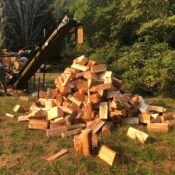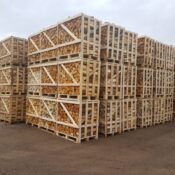Hard Wood And Soft Wood
When it comes to firewood, the two main categories are hardwood and softwood. The key difference between the two is their density, with hardwood being denser than softwood. This difference affects how they burn and what they are best used for.
Hardwood is denser and therefore burns slower and hotter than softwood. This makes it ideal for use in wood burning stoves as it produces more heat and requires less frequent refilling. Some of the most common hardwoods used for firewood include oak, hickory, maple, and ash. Oak is known for its slow-burning properties and high heat output, making it a popular choice for wood burning stoves. Hickory produces a pleasant aroma when burned and is known for its even burn. Maple is another hardwood that burns hot and produces a pleasant scent, making it a great choice for wood burning stoves. Ash is known for its high heat output and long-lasting burn time, making it an efficient choice for wood burning stoves.
Softwood, on the other hand, is less dense and therefore burns faster than hardwood. This makes it ideal for use as kindling to start a fire, especially in wood burning stoves. Softwood kindling ignites quickly and helps establish a hot flame, which can then be sustained with the use of hardwood logs. Some of the most common softwoods used for kindling include pine, spruce, and fir. Pine is popular for its high resin content, which makes it easy to ignite and produces a pleasant aroma when burned. Spruce is not as dense as pine but still burns hot and is commonly used as kindling. Fir is known for its quick-burning properties and is often used as kindling or for outdoor fires.
It’s important to note that while hardwood is better suited for wood burning stoves, it can still be used as kindling when necessary. Softwood, on the other hand, is not recommended for use in wood burning stoves as it burns too quickly and can produce excessive smoke and sparks. It’s also important to make sure the firewood is properly seasoned, meaning it has been allowed to dry out for at least six months to reduce moisture content. Wet or unseasoned firewood can produce excessive smoke and contribute to the build-up of creosote in the chimney, which can lead to chimney fires.Hard Wood And Soft Wood
In conclusion, the main difference between hardwood and softwood for burning is their density, which affects how they burn and what they are best used for. Hardwood is better for use in wood burning stoves, while softwood is better for use as kindling or for outdoor fires. Some common hardwoods include oak, hickory, maple, and ash, while common softwoods include pine, spruce, and fir. Properly seasoned firewood is essential for efficient and safe burning, regardless of the type of wood used.


 SMOKELESS COAL
SMOKELESS COAL BRIQUETTES
BRIQUETTES GAS HEATERS
GAS HEATERS Calor Gas Heaters
Calor Gas Heaters Gas Boilers
Gas Boilers Gas Greenhouse Heaters
Gas Greenhouse Heaters Gas Space Heaters
Gas Space Heaters WATER HEATERS
WATER HEATERS Caravan Water Heaters
Caravan Water Heaters Commercial Continuous Flow Gas Water Heaters
Commercial Continuous Flow Gas Water Heaters FIREWOOD
FIREWOOD KILN DRIED LOGS
KILN DRIED LOGS HOME HEATING OIL TANKS
HOME HEATING OIL TANKS Bunded
Bunded Single Skinned Tanks
Single Skinned Tanks WOOD PELLETS
WOOD PELLETS FUEL STORAGE
FUEL STORAGE Coal Bunkers
Coal Bunkers Log Storage
Log Storage







